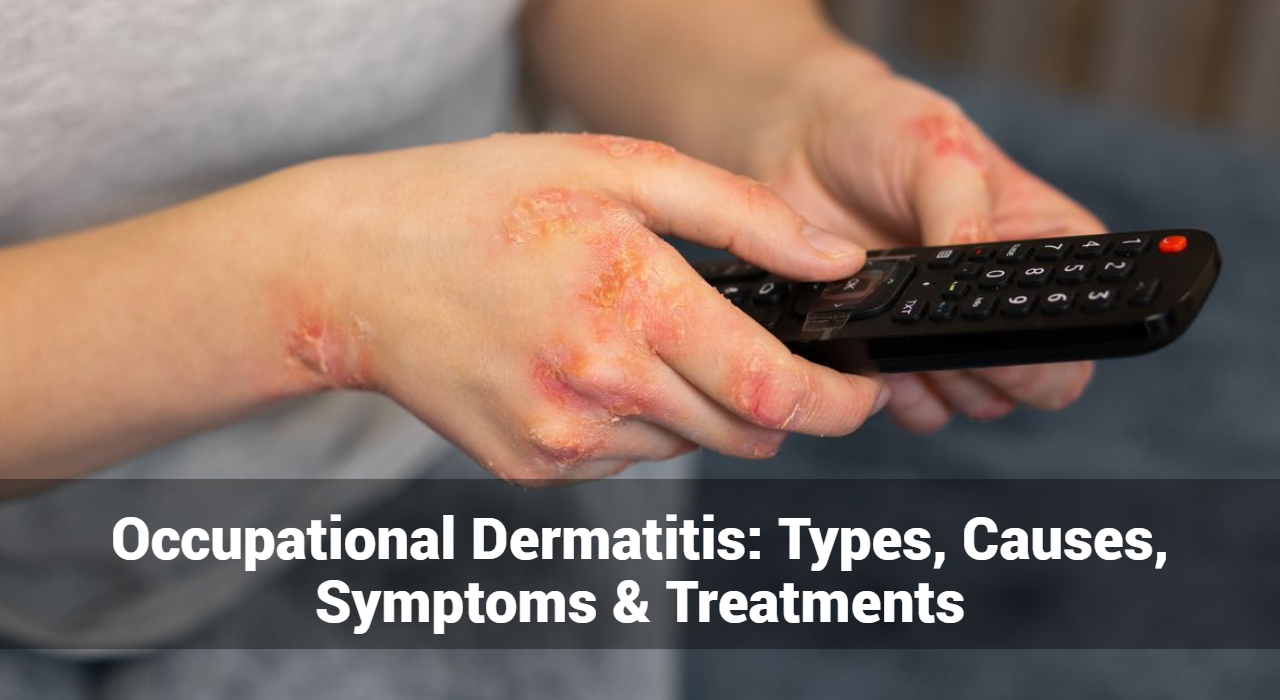Occupational Dermatitis: Types, Causes, Symptoms & Treatments

Occupational dermatitis is a common work-related skin condition resulting from exposure to irritants or allergens in the workplace. It significantly impacts the quality of life and productivity of affected individuals. Understanding the types, causes, symptoms, and treatments is essential for effective management and prevention.
What is Occupational Dermatitis?
Occupational dermatitis is a type of skin inflammation caused or aggravated by workplace exposures. It is one of the most common occupational diseases and can significantly impact an individual’s quality of life and work productivity.
What Are The Types of Occupational Dermatitis?
Occupational dermatitis is a broad term for skin conditions caused or aggravated by workplace exposures. There are two main types of occupational dermatitis: irritant contact dermatitis and allergic contact dermatitis. Here’s an overview of each type, including their causes, symptoms, and treatments.
1. Irritant Contact Dermatitis (ICD)
Irritant Contact Dermatitis (ICD) is a type of skin inflammation caused by direct damage to the skin from contact with irritants. It is the most common form of occupational dermatitis and can occur in any work environment where the skin is exposed to harsh substances or conditions.
Causes:
ICD results from direct damage to the skin by chemical, physical, or biological agents. Common causes include:
- Chemical Irritants: Acids, alkalis, solvents, detergents, and disinfectants. Frequent exposure to these substances can disrupt the skin barrier, leading to inflammation and irritation.
- Physical Irritants: Friction, pressure, extreme temperatures (heat and cold), and prolonged exposure to water (wet work). These factors can cause mechanical damage to the skin.
- Biological Irritants: Bodily fluids such as blood and saliva, particularly in healthcare settings, can cause dermatitis.
Symptoms:
- Redness and Swelling: The affected area often becomes red and swollen.
- Dry, Cracked Skin: Skin may appear dry, cracked, and scaly.
- Pain and Itching: The area may be painful or itchy.
- Blisters: In severe cases, blisters can form.
Treatment:
- Avoidance of Irritants: Identifying and avoiding contact with the irritant.
- Barrier Creams and Moisturizers: Regular application to protect and repair the skin.
- Topical Steroids: Used to reduce inflammation and promote healing.
- Proper Hand Hygiene: Using gentle cleansers and moisturizing frequently.
2. Allergic Contact Dermatitis (ACD)
Allergic Contact Dermatitis (ACD) is an inflammatory skin condition caused by an immune reaction to a substance (allergen) that comes into contact with the skin. This type of occupational dermatitis involves a delayed hypersensitivity reaction, typically occurring 24 to 72 hours after exposure.
Causes:
ACD occurs when the skin becomes sensitized to an allergen, leading to an immune response upon subsequent exposures. Common causes include:
- Metals: Nickel, cobalt, and chromium, often found in tools, machinery, and jewelry.
- Latex: Used in gloves and other medical supplies, common in healthcare and laboratory environments.
- Fragrances and Preservatives: Found in personal care products, cosmetics, and industrial products.
- Rubber Additives: Chemicals used in the manufacture of rubber products like gloves and handles.
- Dyes and Resins: Used in textiles, printing, and manufacturing industries.
- Plants: Certain plants and plant products, such as poison ivy, can cause allergic reactions.
Symptoms:
- Rash and Redness: The affected area develops a red rash.
- Blisters and Oozing: Blisters may form and ooze fluid.
- Swelling: The area may become swollen and inflamed.
- Itching and Burning: Severe itching and a burning sensation are common.
Treatment:
- Identification and Avoidance: Identifying the allergen through patch testing and avoiding exposure.
- Topical Corticosteroids: Applied to reduce inflammation and itching.
- Oral Antihistamines: Used to relieve itching.
- Emollients: Moisturizers to soothe and repair the skin barrier.
Other Types of Occupational Dermatitis
Track and Manage your Eczema treatment using a comprehensive Eczema App
Download Eczemaless now
3. Photoallergic Contact Dermatitis
Photoallergic Contact Dermatitis is a type of skin inflammation triggered by a reaction between a chemical on the skin and exposure to ultraviolet (UV) light. This condition involves a delayed hypersensitivity reaction, usually manifesting 24 to 72 hours after exposure to both the allergen and sunlight.
Causes of Photoallergic Contact Dermatitis:
- Topical Medications:
- Sunscreens: Certain chemical ingredients like oxybenzone.
- Antibiotics: Topical antibiotics such as sulfonamides.
- NSAIDs: Nonsteroidal anti-inflammatory drugs applied to the skin.
- Personal Care Products:
- Fragrances: Found in perfumes and lotions.
- Preservatives: Chemicals used to extend the shelf life of cosmetics and skin care products.
- Industrial Chemicals:
- Coal Tar: Used in treatments for skin conditions like psoriasis.
- Dyes: Chemicals used in various industrial processes.
Symptoms of Photoallergic Contact Dermatitis:
- Redness and Swelling: Inflammation typically in areas exposed to sunlight.
- Itching and Burning: The affected skin can be intensely itchy and may have a burning sensation.
- Blisters: Fluid-filled blisters that may ooze and crust over.
- Eczema-like Rash: The skin may develop a rash that resembles eczema.
Treatment of Photoallergic Contact Dermatitis:
- Avoidance of Allergen and Sunlight: Identifying and avoiding the specific chemical causing the reaction, and limiting exposure to sunlight.
- Topical Corticosteroids: Reducing inflammation and relieving itching.
- Oral Antihistamines: Used to manage itching and discomfort.
- Cool Compresses: Soothe the skin and reduce inflammation.
- Emollients: Help to repair the skin barrier and prevent dryness.
4. Contact Urticaria
Contact urticaria, also known as hives, is an immediate allergic reaction that occurs when the skin comes into direct contact with an allergen or irritant. Unlike other forms of contact dermatitis that may take hours or days to develop, contact urticaria typically appears within minutes of exposure.
Causes of Contact Urticaria
Contact urticaria can be triggered by a wide variety of substances, which can be classified into two categories: immunologic and non-immunologic.
Immunologic (Allergic) Contact Urticaria:
- Proteins: Latex, animal dander, and certain foods (e.g., fruits, vegetables, and seafood).
- Plants: Nettle, some herbs, and spices.
- Chemicals: Preservatives, fragrances, and certain medications applied to the skin.
Non-Immunologic (Irritant) Contact Urticaria:
- Chemicals: Organic solvents, certain industrial chemicals, and some cosmetics.
- Physical Agents: Cold, heat, and pressure can also provoke a non-immunologic reaction.
Symptoms of Contact Urticaria
Symptoms of contact urticaria are typically localized to the area of contact but can spread, especially in severe cases. They include:
- Hives (Urticaria): Red, raised, itchy welts that can vary in size and shape.
- Itching and Burning: Intense itching and a burning sensation at the site of contact.
- Swelling (Angioedema): Swelling of deeper layers of the skin, particularly around the eyes, lips, and throat.
- Systemic Symptoms: In severe cases, symptoms can include anaphylaxis, characterized by difficulty breathing, rapid heartbeat, and a drop in blood pressure, requiring immediate medical attention.
Treatment of Contact Urticaria
The primary treatment goals are to relieve symptoms and prevent future reactions:
- Avoidance of Triggers: Identifying and avoiding contact with known allergens and irritants.
- Antihistamines: Used to relieve itching and reduce hives.
- Corticosteroids: Topical or oral corticosteroids to reduce inflammation.
- Epinephrine: For severe reactions or anaphylaxis, an epinephrine auto-injector (e.g., EpiPen) is essential.
- Cool Compresses: Applying cool compresses to the affected area can provide symptomatic relief.
What Are The Common Workplace Sources and Risk Factors?
- Healthcare: Frequent handwashing, use of latex gloves, and exposure to disinfectants.
- Construction and Manufacturing: Contact with cement, solvents, and other industrial chemicals.
- Hairdressing and Beauty: Exposure to dyes, bleaches, and other hair and skin products.
- Food Industry: Prolonged exposure to water, detergents, and food products.
- Agriculture: Contact with pesticides, fertilizers, and plant allergens.
GET IN CONTROL OF YOUR ECZEMA
Use our AI tool to check the severity of Eczema and keep track of your Eczema progress.
Preventive Measures From Occupational Dermatitis
- Personal Protective Equipment (PPE): Gloves, protective clothing, and barrier creams.
- Workplace Controls: Implementing engineering controls to minimize exposure, such as ventilation systems and safe handling procedures.
- Education and Training: Educating workers about risks, proper skin care, and safe handling practices.
- Skin Care: Regular use of moisturizers and mild skin cleansers to maintain skin barrier integrity.
While professional medical advice and proper workplace safety measures are crucial for managing and preventing occupational dermatitis, natural remedies can also help alleviate symptoms and promote skin healing. Here are some natural remedies that might be beneficial:
Natural Remedies for Occupational Dermatitis
While professional medical advice and proper workplace safety measures are crucial for managing and preventing occupational dermatitis, natural remedies can also help alleviate symptoms and promote skin healing. Here are some natural remedies that might be beneficial:
- Aloe Vera
- Benefits: Aloe vera has anti-inflammatory and soothing properties.
- Usage: Apply pure aloe vera gel directly to the affected areas. Ensure it’s 100% aloe vera without added fragrances or alcohol.
- Coconut Oil
- Benefits: Coconut oil is a natural moisturizer with antimicrobial properties.
- Usage: Apply virgin coconut oil to the skin to keep it hydrated and help repair the skin barrier.
- Oatmeal Baths
- Benefits: Colloidal oatmeal can relieve itching and inflammation.
- Usage: Add finely ground oatmeal to a lukewarm bath and soak for 15-20 minutes.
- Chamomile
- Benefits: Chamomile has anti-inflammatory and soothing effects.
- Usage: Apply chamomile tea bags or a compress soaked in chamomile tea to the affected areas.
- Honey
- Benefits: Honey has antibacterial and wound-healing properties.
- Usage: Apply raw honey to the affected skin, leave it on for 15-20 minutes, and then rinse off gently with lukewarm water.
- Calendula
- Benefits: Calendula has anti-inflammatory and healing properties.
- Usage: Use calendula ointment or cream on the affected areas.
- Tea Tree Oil
- Benefits: Tea tree oil has anti-inflammatory and antimicrobial properties.
- Usage: Dilute tea tree oil with a carrier oil (like coconut oil) before applying to the skin. Do a patch test first to check for any sensitivity.
- Cucumber Slices
- Benefits: Cucumbers are soothing and can reduce inflammation.
- Usage: Place slices of fresh cucumber on the affected areas for a cooling effect.
- Apple Cider Vinegar
- Benefits: Apple cider vinegar has antibacterial and antifungal properties.
- Usage: Dilute apple cider vinegar with water (1 part vinegar to 3 parts water) and apply with a cotton ball. Avoid using it on open or cracked skin.
- Olive Oil
- Benefits: Olive oil is a natural moisturizer rich in antioxidants.
- Usage: Apply extra virgin olive oil to the skin to help retain moisture and promote healing.
Additional Tips
- Stay Hydrated: Drinking plenty of water helps maintain overall skin health.
- Diet: A diet rich in antioxidants, vitamins, and omega-3 fatty acids can support skin healing. Include foods like fruits, vegetables, nuts, and fatty fish.
- Avoid Triggers: Identify and avoid substances that trigger your dermatitis.
Conclusion
Managing occupational dermatitis involves a combination of preventive measures, early detection, and appropriate treatment. Collaboration between employers and employees is crucial to create a safe and healthy work environment. Always consult with a healthcare provider for personalized diagnosis and treatment plans.
Track and Manage your Eczema treatment using a comprehensive Eczema App
Download Eczemaless now



